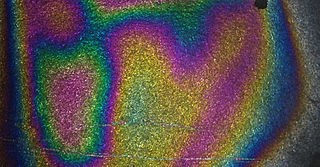
Rainbow Bookmarks
In this activity, students trap an extremely thin layer of clear nail polish which causes interference of light waves making a rainbow layer on a black bookmark. PDF
QUESTION
What happens when light reflects off thin layers of materials?
Background
The reason the rainbow is seen is because the layer of clear nail polish is so thin that it reflects light in different wavelengths. Slight difference in thickness cause light waves of different length to interfere with each other– sometimes cancelling and sometimes reinforcing. Other examples of where we see this in nature is with car oil spills on the wet roads, as well as when looking at many colorful bird feathers such as peacocks. The peacock feather is actually fairly dark brown and not colorful. But there are thin variations in the thickness of the colorful side, and this causes light to reflect in different wavelengths, producing the colors we see. If we were to smash a feather totally flat, the color would be greatly reduced.
Research Connection
In nanotechnology properties often emerge that are not present in bulk materials. In this case the layer is approximately 1 micron in thickness. Interference of light is used to measure thickness in an instrument known as an ellipsometer. Thin films are using for ant-reflective coatings on windows and solar panels which can control the light of a given wavelength that is reflected or absorbed.

NGSS Standards
| MS-PS4-2 | Develop and use a model to describe that waves are reflected, absorbed, or transmitted through various materials. |
| HS-PS4-1. | Use mathematical representations to support a claim regarding relationships among the frequency, wavelength, and speed of waves traveling in various media. |
Materials
- Clear nail polish
- Black card stock or construction paper 2”x 5”
- Water
- Plastic tub
- Tweezers
- Hair dryer
Procedure
- Fill the tub halfway with water. This same water can be used until it gets really dirty/purple/black from dye in the paper bleeding into it. When this happens, replace the water.
- Have kids use the silver sharpie markers to draw or write on their bookmark. They can draw whatever they want.
- Place bookmark in water, and use tweezers to submerge it.
- Drip one drop of nail polish onto surface of water and explain how the nail polish it is hydrophobic, meaning that it hates/repels water. This is why the nail polish spreads into an extremely thin film on the top of the water. Do you see any colors that weren’t there before?
- Pull the bookmark up thru the thin film, trying to deposit the film onto the bookmark. This should create a rainbow effect on the bookmark when dry. Usually it looks sort of circular, depending on how the polish spread.
- Dry the bookmark on a paper towel using a hair dryer.
- When the bookmark has dried, hold it up to the light. Do you see any new colors? What happens as you move it around, bend it, hold it at different angles? Where do the colors come from?
- You may need to use the tweezers or a paper towel to occasionally clean/skim the extra nail polish off the water surface. You do not need to do this cleaning each time, but you will find that the bookmarks look a lot nicer if you have very little nail polish floating on the top when you start the experiment each time.
Liquid Crystal Extension
Demonstrate the thermochromatic liquid crystal display or thermometer which also works on the principle of interference of light bouncing off of two layers of self-aligning crystals. When the material is hot the layers are close together and they reflect blue, when it is cold the layers are farther apart and they reflect red. The thermometer has a series of liquid crystals each formulated to change at a different temperature.




